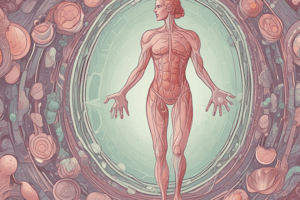Podcast
Questions and Answers
What are the 3 different classifications of hormones?
What are the 3 different classifications of hormones?
- Steroid hormones (correct)
- Non-steroid hormones (correct)
- Peptide hormones (correct)
What are the factors that affect hormone concentrations in the blood? (Select all that apply)
What are the factors that affect hormone concentrations in the blood? (Select all that apply)
- Negative Feedback (correct)
- Concentration levels are not static but dynamically changing (correct)
- Pulsatile hormone release pattern (correct)
- Hormone plasma concentrations are highly variable (correct)
What are the major cardiovascular system functions?
What are the major cardiovascular system functions?
The major cardiovascular system functions include transporting oxygen and nutrients to tissues, removing carbon dioxide and waste products, regulating body temperature, and maintaining blood pressure.
What is the Fick equation and what does it calculate?
What is the Fick equation and what does it calculate?
Describe the cardiovascular responses to acute exercise.
Describe the cardiovascular responses to acute exercise.
What factors determine stroke volume and cardiac output?
What factors determine stroke volume and cardiac output?
Why does stroke volume change during exercise? By what mechanism?
Why does stroke volume change during exercise? By what mechanism?
What are the differences between strength, power, and endurance?
What are the differences between strength, power, and endurance?
How does blood flow change during exercise?
How does blood flow change during exercise?
What is residual volume, tidal volume, vital capacity, total lung capacity & functional residual capacity?
What is residual volume, tidal volume, vital capacity, total lung capacity & functional residual capacity?
Flashcards
Steroid hormones
Steroid hormones
Hormones chemically similar to cholesterol, directly derived from it, and lipid-soluble.
Non-steroid hormones
Non-steroid hormones
Hormones that are not lipid-soluble and cannot easily cross cellular membranes.
Protein hormones
Protein hormones
A type of non-steroid hormone.
Peptide hormones
Peptide hormones
Signup and view all the flashcards
Pulsatile hormone release
Pulsatile hormone release
Signup and view all the flashcards
Negative feedback
Negative feedback
Signup and view all the flashcards
Growth hormone
Growth hormone
Signup and view all the flashcards
Antidiuretic hormone
Antidiuretic hormone
Signup and view all the flashcards
Testosterone
Testosterone
Signup and view all the flashcards
Estrogen
Estrogen
Signup and view all the flashcards
Catecholamines
Catecholamines
Signup and view all the flashcards
Cortisol
Cortisol
Signup and view all the flashcards
Insulin
Insulin
Signup and view all the flashcards
Glucagon
Glucagon
Signup and view all the flashcards
Stroke Volume
Stroke Volume
Signup and view all the flashcards
Cardiac Output
Cardiac Output
Signup and view all the flashcards
Ejection Fraction
Ejection Fraction
Signup and view all the flashcards
Fick Equation
Fick Equation
Signup and view all the flashcards
HR max
HR max
Signup and view all the flashcards
ECG
ECG
Signup and view all the flashcards
Tidal Volume
Tidal Volume
Signup and view all the flashcards
Residual Volume
Residual Volume
Signup and view all the flashcards
Study Notes
Hormonal Control/Endocrinology (Ch. 4)
- Hormones are classified as steroid, non-steroid (protein or peptide), and amino acid-derived
- Steroid hormones are lipid-soluble, derived from cholesterol, and directly cross cell membranes
- Non-steroid hormones are not lipid-soluble and require receptors to initiate effects
- Hormone release is pulsatile, not constant
- Hormone concentrations are regulated by negative feedback mechanisms
- Hormone release is affected by various factors, including hormone concentrations, physical conditions, and physiological responses
- Factors affecting hormone production/release can include growth hormone, antidiuretic hormone, testosterone, estrogen, catecholamines, cortisol, insulin, and glucagon
Cardiovascular System (Ch. 7)
- Cardiovascular functions include major functions like blood circulation, fluid balance, and delivering oxygen.
- Cardiac conduction system (e.g., SA node) details are essential for understanding the heart's electrical activity
- Cardiac cycle details (e.g., systole, diastole) should be known
- Understand concepts like stroke volume, cardiac output, and ejection fraction related to cardiac efficiency.
- How blood flow changes are essential to understand
- ECG (P, QRS, T waves) are used to measure heart rate.
Cardiorespiratory Responses to Exercise (Ch. 9)
- Fick equation calculation is necessary to understand oxygen consumption in exercise contexts.
- Heart rate maximum (HR max) calculation is important for exercise prescription.
- Understanding cardiovascular responses (e.g., changes in heart rate, stroke volume and cardiac output) to acute exercise is crucial
- Understanding changes in stroke volume during acute exercise is vital to exercise prescription
- Understanding blood flow changes during exercise is important.
- Respiratory volume measurements (e.g., residual volume, tidal volume, vital capacity, and total lung capacity)
- Functional residual capacity is also essential
Principles of Exercise Training (Ch.10)
- Differences between strength, power, and endurance are key to different types of exercise training.
Adaptations to Resistance Training (Ch. 11,12)
- Understands the mechanisms behind strength gains.
- Understand fiber hypertrophy and hyperplasia
- Know about DOMS (Delayed Onset Muscle Soreness)
Adaptations to Aerobic and Anaerobic Training (Ch. 11,12)
- Understand how exercise professionals evaluate aerobic endurance
- Understand how Fick equation and other measures are used.
- Know about adaptations to cardiovascular system during endurance training
- Factors affecting VO2 max should be known.
- Different parameters of exercise prescription and program design
Laboratory Section
- Methods of Body Composition assessment, including skin-fold, hydrostatic weighing, anthropometric, etc.
- Understand calculating ideal body weight, BMI, etc.
- ECG procedures (lead placement, PQRST waves, HR calculation from ECG).
- Aerobic capacity measurements (VO2 max, indirect methods, and pulmonary spirometry).
- Relevant units (METs, kcals) and calculations
Anaerobic Power
- Relationship between work and power
- Anaerobic assessments (e.g. Treadmill test, Wingate test)
Studying That Suits You
Use AI to generate personalized quizzes and flashcards to suit your learning preferences.
Related Documents
Description
This quiz covers key concepts from chapters on hormonal control and the cardiovascular system. It explores hormone classifications, the nature of steroid and non-steroid hormones, and details of the cardiovascular functions. Test your knowledge on these crucial physiological systems.




